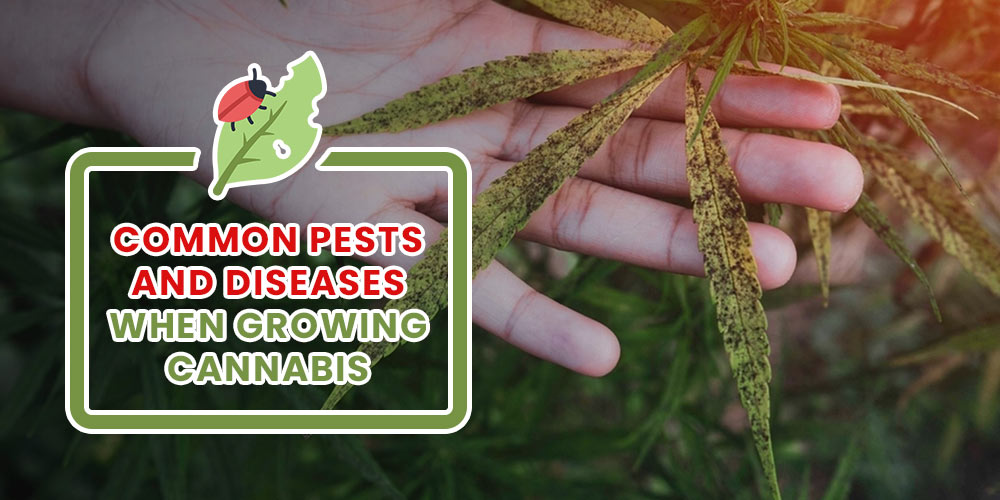



Common cannabis diseases and pests can significantly impact cannabis cultivation because they can cause damage to the plants, reduce their yields, and even lead to crop failure. Pests such as spider mites, thrips, and aphids can feed on the plant’s leaves and sap, causing damage and weakening the plant’s overall health. Similarly, diseases such as powdery mildew, bud rot, and root rot can weaken the plant, reduce yields, and even kill the plant. Controlling pests and diseases in cannabis cultivation is therefore critical to ensure healthy plant growth, high yields, and quality products. This can be done through preventive measures, such as maintaining a clean and sanitized growing environment. This blog will discuss the most common pest and diseases you can identify early to prevent.
Cannabis plants are susceptible to various pests that can cause significant damage to foliage, flowers, and roots. Here are some of the most common pests in cannabis cultivation and their prevention and treatment options:
Spider mites: Spider mites are tiny arachnids that feed on the plant’s sap and produce webbing that covers the leaves and buds. They can cause yellowing, wilting, and drying of the leaves and buds, reducing the yield and potency of the plant. Prevention includes keeping the growing area clean and debris-free, using sticky traps, and avoiding over-fertilization. Treatment options include spraying the plants with water and neem oil, insecticidal soap, or pyrethrin-based insecticides.
Aphids: Small insects suck the plant’s sap and excrete honeydew, attracting ants and promoting mold growth. They can cause yellowing, curling, and distortion of the leaves and buds and transmit plant viruses. Prevention includes using natural predators such as ladybugs and lacewings and avoiding over-fertilization. Treatment options include spraying the plants with water and soap, neem oil, or pyrethrin-based insecticides.
Whiteflies: Whiteflies are tiny white insects that fly around the plant and suck its sap, causing yellowing, curling, and stunted growth. They also excrete honeydew, promoting mold growth and attracting ants. Prevention includes using sticky traps and avoiding over-fertilization. Treatment options include spraying the plants with neem oil, insecticidal soap, or pyrethrin-based insecticides.
Thrips: Thrips are small insects that feed on the plant’s sap and cause silver or white streaks on the leaves and buds. They can also transmit plant viruses and cause bud rot. Prevention includes using natural predators such as mites and nematodes and avoiding over-fertilization. Treatment options include spraying the plants with neem oil, insecticidal soap, or pyrethrin-based insecticides.
Caterpillars: Caterpillars are the larvae of moths and butterflies that feed on the leaves and buds, causing holes and damage. They can also transmit plant viruses and cause bud rot. Prevention includes using natural predators such as birds and wasps and avoiding over-fertilization. Treatment options include manually removing the caterpillars, spraying the plants with Bacillus thuringiensis (Bt) insecticide, or using sticky traps.
Just like pests, cannabis plants are also susceptible to diseases and here are some of the most common diseases in cannabis cultivation and their prevention and treatment options:
Powdery mildew: Powdery mildew is a fungal disease that appears as a white or gray powdery coating on the leaves, stems, and buds, reducing the yield and potency of the plant. It thrives in warm, humid conditions and can spread quickly. Prevention includes maintaining good air circulation, reducing humidity levels, avoiding overcrowding, and keeping the growing area clean. Treatment options include spraying the plants with water, baking soda, hydrogen peroxide, or potassium bicarbonate.
Botrytis (bud rot): Botrytis is a fungal disease that attacks the buds and flowers, causing them to turn brown and wilt. It spreads quickly and can lead to mold growth and other secondary infections. Prevention includes maintaining good air circulation, reducing humidity levels, avoiding over-watering, and keeping the growing area clean. Treatment options include removing the infected buds and spraying the plants with a fungicide such as potassium bicarbonate or hydrogen peroxide.
Fusarium: Fusarium is a fungal disease that attacks the roots, causing them to turn brown and rot. It can also affect the stems and leaves, causing yellowing and wilting. Prevention includes avoiding over-watering, using clean soil and containers, and maintaining good hygiene. Treatment options include removing the infected plants, sterilizing the soil and containers, and using fungicides such as copper-based products.
Verticillium wilt: Verticillium wilt is a fungal disease that attacks the roots, causing them to turn brown and wilt. It can also affect the leaves, causing yellowing and wilting. Prevention includes avoiding over-watering, using clean soil and containers, and maintaining good hygiene. Treatment options include removing the infected plants, sterilizing the soil and containers, and using fungicides such as copper-based products.
Root rot: Root rot is a fungal disease that attacks the roots, causing them to turn brown and rot. It can also affect the stems and leaves, causing yellowing and wilting. Prevention includes avoiding over-watering, using clean soil and containers, and maintaining good hygiene. Treatment options include removing the infected plants, sterilizing the soil and containers, and using fungicides such as copper-based products.



Best Selling
Feminized Seeds
Regular Seeds
Customer Help
Contact Us
WE SELL MARIJUANA SEEDS IN THE USA

Are You 18 Or Over?
YesOr
No By clicking yes, you certify that you are over 18. By using this website, you agree to our legal disclaimer.